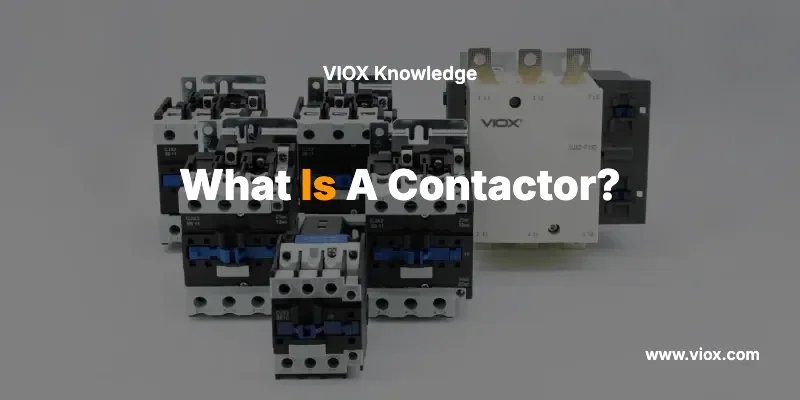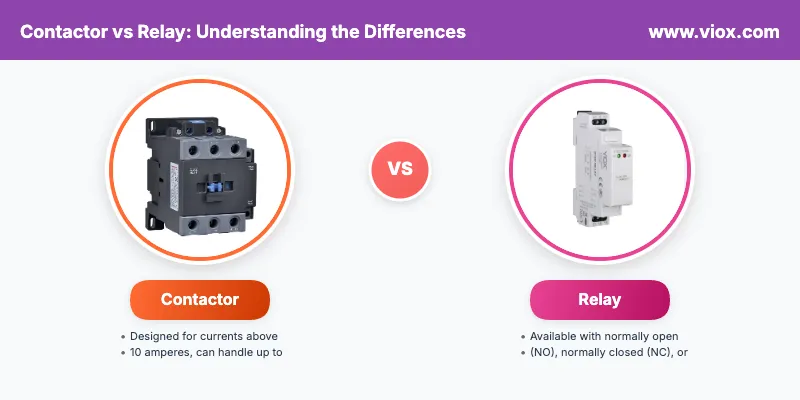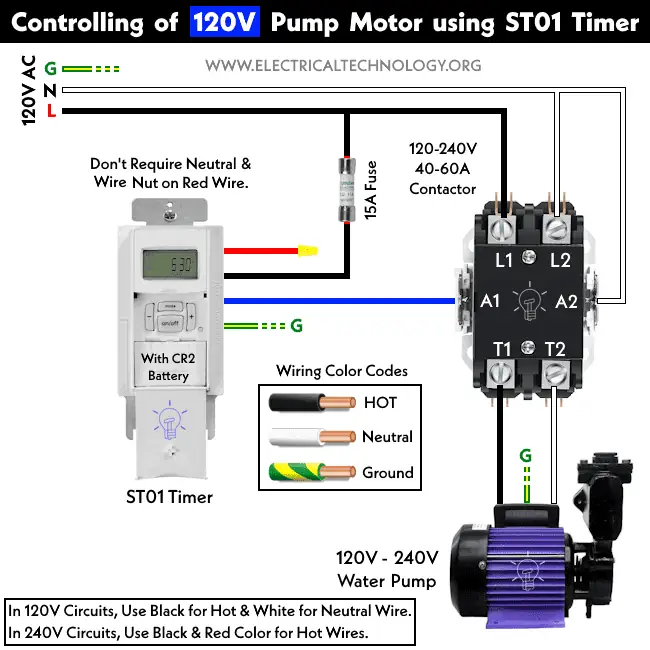Bevezetés
Az elektromos kontaktor egy speciális kapcsolóeszköz, amelyet nagy teljesítményű elektromos áramkörök biztonságos és hatékony vezérlésére terveztek. A hagyományos kapcsolókkal ellentétben a kontaktorok elektromágneses elveket alkalmaznak az elektromos csatlakozások nyitására és zárására, így nélkülözhetetlen alkotóelemei az ipari automatizálásnak, a motorvezérlésnek és a kereskedelmi elektromos rendszereknek.
A kontaktor fogalma és működésének megértése elengedhetetlen mindenki számára, aki elektromos rendszerekkel foglalkozik, a mérnököktől és technikusoktól kezdve az üzemvezetőkig. Ez az átfogó útmutató mindent elmagyaráz, amit a villamos kontaktorokról, azok alkalmazásairól és arról tudnia kell, hogy miért nélkülözhetetlenek a modern villamos berendezésekben.
Mi az a kontaktor?
A kontaktor egy elektromechanikus kapcsolóeszköz, amely elektromágneses tekercset használ az elektromos érintkezők nyitásának és zárásának vezérlésére, lehetővé téve a nagy teljesítményű áramkörök biztonságos vezérlését. Az eszköz elektromosan működtetett kapcsolóként működik, lehetővé téve az alacsony feszültségű vezérlőáramkörök számára a nagyfeszültségű, nagyáramú elektromos terhelések biztonságos kezelését.
A kontaktorok főbb jellemzői:
- Távoli működtetésAlacsony feszültségű jelekkel távolról vezérelhető
- Nagy áramerősségJelentős elektromos terhelések (jellemzően 10 amper felett) kezelésére tervezték
- Gyakori váltásTöbb ezer be- és kikapcsolási ciklusra tervezték, degradáció nélkül
- Biztonsági leválasztás: Elektromos leválasztást biztosít a vezérlő- és a tápáramkörök között
- Elektromágneses működésMágneses erőt használ a megbízható érintkezőműködtetéshez
Hogyan működik egy kontaktor?
A kontaktor működési elve az elektromágneses vonzáson és a rugóvisszatérítéses mechanizmusokon alapul:
Lépésről lépésre működés:
- EnergizálásAmikor feszültséget kapcsolunk a kontaktor tekercsére (általában 24 V, 120 V vagy 240 V), mágneses mezőt hozunk létre.
- Mágneses vonzásA mágneses mező egy mozgatható vasmagot (armatúrát) vonz a rögzített elektromágneses mag felé.
- Kapcsolat bezárásaAz armatúra mozgása a mozgó érintkezőket a rögzített érintkezőkhöz kényszeríti, ezzel lezárva az áramkört.
- ÁramfolyásAz elektromos áram mostantól átfolyhat a fő érintkezőkön, hogy táplálja a csatlakoztatott terhelést.
- FeszültségmentesítésAmikor a tekercs áramellátását megszüntetik, a mágneses mező összeomlik.
- Tavaszi visszatérésA rugóerő visszahúzza az armatúrát, kinyitja az érintkezőket és megszakítja az áram folyását
Elektromágneses alkatrészek:
Tekercs/ElektromágnesA kontaktor szíve, amely feszültség alatt mágneses mezőt hoz létre
ForgórészA mozgatható vasmag, amely reagál a mágneses mezőre
KapcsolatVezetőképes elemek, amelyek létrehozzák vagy megszakítják az elektromos csatlakozást
Springs: Biztosítsa a visszatérő erőt a nyitó érintkezőkhöz, amikor a tekercs feszültségmentes állapotban van
A kontaktorok típusai
AC kontaktorok
A váltakozó áramú kontaktorokat kifejezetten váltakozó áramú alkalmazásokhoz tervezték, és ezek a leggyakrabban használt típusok kereskedelmi és ipari környezetben.
Kulcsfontosságú jellemzők:
- Laminált magszerkezetSzilícium-acél laminátumokat használ az örvényáram-veszteségek csökkentése érdekében
- Ív elnyomásaÍvcsatornákat és mágneses kifúvást tartalmaz az ívek gyors eloltásához
- Háromfázisú képességJellemzően háromfázisú motoráramkörök vezérlésére tervezték
- Feszültségi értékek120 V-tól 1000 V+-ig elérhető
Gyakori alkalmazások:
- Villanymotorok vezérlése (szivattyúk, ventilátorok, kompresszorok)
- HVAC rendszer váltása
- Világításvezérlő rendszerek
- Ipari gépek automatizálása
DC kontaktorok
Az egyenáramú kontaktorok egyenáramú terheléseket kezelnek, és speciális tervezési elemekkel rendelkeznek az egyenáramú kapcsolás egyedi kihívásainak kezelésére.
Kulcsfontosságú jellemzők:
- Tömör acélmagSzilárd ferromágneses anyagokat használ, mivel az örvényáramok nem jelentenek problémát
- Fokozott ívelnyomásA folyamatos áram miatt robusztusabb ívoltási módszereket igényel
- Mágneses kifújásGyakran mágneses lefújótekercseket tartalmaz, hogy az íveket elterelje az érintkezőktől
- Nagyobb érintkezési résNagyobb elválasztási távolságok a megbízható ívkioltás érdekében
Gyakori alkalmazások:
- Napelemes rendszerek és akkumulátortelepek
- Egyenáramú motorvezérlés (liftek, daruk)
- Elektromos járművek töltőrendszerei
- Vasúti és tömegközlekedési alkalmazások
Speciális kontaktor típusok
- Fordító kontaktorokKettős érintkezőkészlettel rendelkezik a motor forgásirányának biztonságos megfordításához
- Világítástechnikai kontaktorokOhmos terhelésekhez optimalizálva, reteszelő mechanizmusokkal az energiahatékonyság érdekében
- Kondenzátor kontaktorokTeljesítménytényező-korrekciós kondenzátorok kapcsolására tervezték
- Vákuum kontaktorok: Közepes és nagyfeszültségű alkalmazásokhoz vákuumzáras érintkezőket használjon
Kontaktor vs. relé: A különbségek megértése
Bár a kontaktorok és a relék hasonló elektromágneses elveken működnek, eltérő célokat szolgálnak és eltérő jellemzőkkel rendelkeznek:
Terhelhetőség
- Kontaktorok10 amper feletti áramerősségre tervezték, akár több ezer ampert is képes kezelni
- Relék: Általában 10 amper vagy kevesebb áramerősségre van méretezve
Kapcsolat konfiguráció
- KontaktorokElsősorban normál esetben nyitott (NO) érintkezőket használjon, amelyek feszültség alatt zárnak
- RelékNormál esetben nyitott (NO), normál esetben zárt (NC) vagy váltóérintkezőkkel kapható
Fizikai méret és felépítés
- KontaktorokNagyobb, robusztusabb konstrukció a nagy teljesítményű terhelések kezeléséhez
- RelékKompakt kialakítás, amely alkalmas vezérlőáramköri alkalmazásokhoz
Arc elfojtás
- KontaktorokKifinomult ívszűrő mechanizmusokat tartalmaz a nagyáramú kapcsoláshoz
- RelékMinimális ívkisülés-elnyomás, mivel alacsonyabb áramokat kezelnek
Alkalmazások
- KontaktorokMotorvezérlés, világítási rendszerek, nehéz ipari terhelések
- RelékJelkapcsolás, vezérlőlogika, kis fogyasztású eszközvezérlés
Biztonsági jellemzők
- KontaktorokGyakran tartalmaznak túlterhelés elleni védelemmel és további biztonsági érintkezőkkel
- RelékAlapvető kapcsolási funkció további védelmi jellemzők nélkül
Kontaktor alkalmazások és felhasználások
Motorvezérlő rendszerek
Hitel a Elektrotechnika
A kontaktorok elengedhetetlenek a motorvezérlési alkalmazásokban, mivel a következőket biztosítják:
- Biztonságos indítás és leállítás elektromos motorok
- Túlterhelés elleni védelem hőkioldó relékkel kombinálva
- Távoli működtetés vezérlőpanelekről vagy automatizálási rendszerekről
- Vészleállási képesség a biztonsági előírásoknak való megfelelés érdekében
Ipari automatizálás
A gyártásban és a folyamatirányításban:
- Szállítószalag-rendszer vezérlése
- Szivattyú és kompresszor működése
- Anyagmozgató berendezések
- Folyamatsor automatizálás
Kereskedelmi épületgépészeti rendszerek
- HVAC vezérlésFűtési, szellőztető és légkondicionáló rendszerek kezelése
- VilágításvezérlésNagy világítási rendszerek vezérlése irodaépületekben, üzlethelyiségekben
- EnergiaelosztásElektromos panelek és elosztótáblák kapcsolása
Energiatermelés és elosztás
- Generátor vezérlőrendszerek
- Kondenzátorbank váltás teljesítménytényező korrekcióhoz
- Alállomás automatizálás
- Megújuló energiarendszerek (nap- és szélenergia)
Kontaktor specifikációk és kiválasztás
Elektromos minősítések
- Feszültség Értékelés: A kontaktor által biztonságosan kezelhető maximális feszültség
- Jelenlegi értékelésMaximális folyamatos áramerősség
- Lóerő-besorolásMotor terhelhetősége adott feszültségeknél
- Felhasználási kategória: Meghatározza a terhelés típusát (AC-1 ohmos terheléshez, AC-3 motorokhoz)
Tekercs specifikációk
- Tekercsfeszültség: Az elektromágneses tekercs üzemi feszültsége (24V, 120V, 240V stb.)
- Tekercs típusaAC vagy DC működés
- Energiafogyasztás: A tekercs gerjesztésének fenntartásához szükséges energia
Mechanikai jellemzők
- Kapcsolattartó anyagEzüstötvözet, ezüst-oxid vagy más speciális anyagok
- Pólusok számaEgypólusú, kétpólusú, hárompólusú vagy négypólusú konfigurációk
- SegédkontaktusokKiegészítő érintkezők a vezérlőáramkör funkcióihoz
- Szerelési típusDIN sínre, panelre szerelhető vagy egyéb telepítési módszerek
Környezeti megfontolások
- Hőmérséklet tartományÜzemi hőmérsékleti korlátok
- Védettségi besorolásVédelem a por, nedvesség és környezeti veszélyek ellen
- Rezgésállóság: Mechanikai igénybevételnek való ellenállás
- Magassági besorolásTeljesítmény különböző magasságokban
Telepítés és kábelezés
Tipikus kontaktor csatlakozások
- Vonalkapcsok (L1, L2, L3): Csatlakoztassa a bejövő tápegységhez
- Terheléskapcsok (T1, T2, T3)Csatlakoztassa az elektromos terheléshez (motor, világítás stb.)
- Tekercscsatlakozók (A1, A2): Csatlakoztassa a vezérlőáramkör feszültségéhez
- SegédkontaktusokJelző-, reteszelő- vagy visszacsatoló áramkörökhöz használják
Vezérlő áramkör integráció
A kontaktorokat jellemzően a következő vezérlőrendszerekbe integrálják:
- Start/stop nyomógombok kézi működtetéshez
- Túlterhelés relék motorvédelemhez
- PLC kimenetek automatizált vezérléshez
- Időzítő relék szekvenciális műveletekhez
Biztonsági megfontolások
- Megfelelő földelés minden fém alkatrészből
- Ívvillanás elleni védelem feszültség alatt álló berendezéseken végzett munka során
- Kizárási/kitáblázási eljárások karbantartás közben
- Megfelelő szabadtávolságok a biztonságos üzemeltetés és karbantartás érdekében
Karbantartás és hibaelhárítás
Rendszeres karbantartási feladatok
- Szemrevételezéses ellenőrzés: Ellenőrizze a túlmelegedés, korrózió vagy fizikai sérülés jeleit
- Kapcsolatvizsgálat: Vizsgálja meg az érintkezőket korrózió, égés vagy túlzott kopás szempontjából
- Tekercsvizsgálat: Ellenőrizze a tekercs megfelelő ellenállását és szigetelését
- Mechanikus működés: Biztosítsa a forgórész sima mozgását és a megfelelő rugóhatást
Gyakori problémák és megoldások
- Nem záródó kapcsolatok: Ellenőrizze a tekercsfeszültséget, a mechanikai akadályokat vagy a kopott rugókat
- Hegesztett érintkezőkÁltalában túláramkörülményeket vagy nem megfelelő ívelnyomást jelez
- Csevegő műveletAlacsony tekercsfeszültségre vagy mechanikai problémákra utalhat
- TúlmelegedésRossz csatlakozások, túlterhelés vagy nem megfelelő szellőzés okozhatja
Csere irányelvek
Cserélje ki a kontaktorokat, ha:
- Az érintkezők túlzott kopást vagy sérülést mutatnak
- A tekercs ellenállása kívül esik a gyártó specifikációin
- A mechanikus működés lassúvá vagy szabálytalanná válik
- Az ívszűrő alkatrészek sérültek
Jövőbeli trendek és technológia
Intelligens kontaktorok
A modern kontaktorok egyre inkább digitális technológiát alkalmaznak:
- Beépített diagnosztika prediktív karbantartáshoz
- Kommunikációs képességek rendszerintegrációhoz
- Energiafogyasztás-felügyelet jellemzők
- Távoli megfigyelés IoT-kapcsolaton keresztül
Szilárdtest alternatívák
Míg az elektromechanikus kontaktorok továbbra is dominánsak, a szilárdtest kapcsolóeszközök a következőket kínálják:
- Gyorsabb kapcsolási sebesség
- Nincs mechanikai kopás
- Csendes működés
- Precíz vezérlési képességek
Következtetés
A kontaktor és annak működésének megértése elengedhetetlen mindenkinek, aki elektromos rendszerekkel dolgozik. Ezek a megbízható, elektromágneses kapcsolóeszközök biztonságos és hatékony vezérlést biztosítanak nagy teljesítményű elektromos terhelések számára számtalan alkalmazásban, az egyszerű motorindítóktól az összetett ipari automatizálási rendszerekig.
Akár új telepítéshez specifikál berendezéseket, akár egy meglévő rendszer hibaelhárítását végzi, akár karbantartási tevékenységeket tervez, a kontaktor működésének, típusainak és alkalmazásainak alapos ismerete segít biztosítani a biztonságos és megbízható elektromos rendszer teljesítményét.
A sikeres kontaktoralkalmazás kulcsa a terhelési követelmények, a környezeti feltételek és a vezérlőrendszer integrációs igényei alapján történő megfelelő kiválasztásban rejlik. Megfelelő telepítés, karbantartás és üzemeltetés mellett a kontaktorok évekig megbízható szolgáltatást nyújtanak az elektromos teljesítményszabályozás igényes világában.
A legfontosabb tudnivalók:
- A kontaktor egy elektromágneses kapcsoló, amelyet nagy teljesítményű elektromos áramkörök vezérlésére terveztek.
- A kontaktorok elsősorban áramvezető képességükben és felépítésükben különböznek a reléktől
- Az AC és DC kontaktorok eltérő kialakításúak, hogy kezelni tudják az adott áramtípusokat.
- A megfelelő kiválasztás, telepítés és karbantartás kulcsfontosságú a biztonságos és megbízható működéshez
- A kontaktorok alapvető alkatrészek a motorvezérlésben, a világítási rendszerekben és az ipari automatizálásban
Gyakran Ismételt Kérdések a Kapcsolattartókról
Mi a különbség a kontaktor és a relé között?
A fő különbségek a teherbírás és a konstrukció. A kontaktorokat 10 amper feletti áramerősségre tervezték, robusztus felépítésűek és ívszűrő mechanizmusokkal rendelkeznek. A relék jellemzően 10 amper vagy annál kisebb áramot kezelnek, és vezérlő áramkörökben használják őket. A kontaktorok elsősorban nyitó, nyitó vagy váltó érintkezőkkel rendelkeznek.
Miért hibásodnak meg vagy égnek ki a kontaktorok?
A kontaktor meghibásodásának gyakori okai a következők:
– Névleges kapacitáson túli túlterhelés
– Túlzott ívképződés okozta érintkezőhegesztés
– A tekercs túlmelegedése feszültségingadozás miatt
– Környezeti tényezők, mint például por, nedvesség vagy korrozív gázok
– Mechanikai kopás a túlzott ciklusok miatt
– Rossz elektromos csatlakozások, amelyek feszültségesést okoznak
Hogyan lehet elhárítani egy nem működő kontaktor hibáját?
Kövesse ezt a szisztematikus megközelítést:
1. Ellenőrizze a vezérlőfeszültséget a tekercs csatlakozóinál (A1, A2)
2. Tekercs ellenállásának mérése multiméterrel
3. Vizsgálja meg az érintkezőket sérülés, korrózió vagy összeforradás szempontjából
4. Ellenőrizze a mechanikai működést – hallja a megfelelő kattanó hangot
5. Ellenőrizze a segédérintkezők folytonosságát
6. Vizsgálja meg a túlterhelésrelé beállításait és működését
Hogyan kell bekötni egy kontaktort motorvezérléshez?
Az alapvető motorvédő kapcsoló bekötése a következőket foglalja magában:
1. Tápcsatlakozások: Csatlakoztassa az L1, L2 és L3 csatlakozókat a bejövő tápegységhez
2. Terheléscsatlakozások: Csatlakoztassa a T1, T2 és T3 jelű csatlakozókat a motor csatlakozóihoz
3. Vezérlő áramkör: A1, A2 vezeték a vezérlőfeszültséghez (jellemzően 24V, 120V vagy 240V)
4. Start/stop gombok: Sorba kötve a tekercs áramkörével
5. Segédérintkezők: Tartó áramkörhöz és állapotjelzéshez használhatók
6. Túlterhelés-relé: Motorvédelem érdekében sorba kell kötni
Mi okozza a kontaktor zúgását vagy zaját?
A kontaktor zörgésének jelei:
– Alacsony vezérlőfeszültség, ami elégtelen mágneses erőt okoz
– Laza elektromos csatlakozások, amelyek feszültségeséseket okoznak
– Sérült árnyékoló tekercs (váltóáramú kontaktorokban)
– Mechanikus akadályok, amelyek megakadályozzák a megfelelő érintkezőzáródást
– Feszültségingadozások a tápellátó rendszerben
– Kopott érintkezőfelületek, amelyek rossz csatlakozásokat eredményeznek
Használható AC kontaktor DC alkalmazásokhoz?
Általában nem ajánlott módosítás nélkül. A váltakozó áramú mágneskapcsolók nem rendelkeznek megfelelő ívkisülés-elnyomással egyenáramú alkalmazásokhoz, mivel az egyenáram nem rendelkezik természetes nulla-átmenettel, mint a váltakozó áram. Ha feltétlenül szükséges, a mágneskapcsolót jelentősen le kell csökkenteni (jellemzően 50% vagy alacsonyabb váltakozó áramú névleges értékre), és további ívkisülés-elnyomást kell hozzáadni. Egyenáramú alkalmazásokhoz mindig jobb egyenáramú névleges áramú mágneskapcsolót használni.
Hogyan lehet ellenőrizni, hogy egy kontaktor hibás-e?
A legfontosabb tesztek a következők:
1. Tekercs ellenállásának vizsgálata: Az ellenállás mérése az A1-A2 csatlakozók között
2. Érintkezőfolytonosság-teszt: Ellenőrizze az ellenállást a fő érintkezők között feszültség alatt (közel nulla ohmnak kell lennie)
3. Szigetelésvizsgálat: Ellenőrizze, hogy nincs-e folytonosság a tekercs és az érintkezők között feszültségmentes állapotban.
4. Mechanikai működés tesztje: Figyelje meg a megfelelő kattanást és az érintkező mozgását
5. Feszültségteszt: Mérje meg a tekercs tényleges feszültségét működés közben
Milyen típusú kontaktorok léteznek?
A fő kontaktor típusok a következők:
– AC kontaktorok: Váltakozó áramú alkalmazásokhoz (leggyakoribb)
– DC kontaktorok: Egyenáramú terhelésekhez tervezve
– Irányváltó kontaktorok: Lehetővé teszik a motor forgásirányának megfordítását
– Világítástechnikai kontaktorok: Ohmos villámterhelésekhez optimalizálva
– Kondenzátor kontaktorok: Teljesítménytényező-korrekciós kondenzátorok kapcsolására tervezték
– Vákuumkontaktorok: Közepes és nagyfeszültségű alkalmazásokhoz
Miért nem kap áramot a kontaktorom?
Gyakori okok a következők:
– Nincs vezérlőfeszültség a tekercs csatlakozóin
– Kiégett biztosíték a vezérlő áramkörben
– Szakadás a vezérlőkábelezésben
– Hibás tekercs (kiégett vagy sérült)
– Mechanikus akadály, amely megakadályozza a armatúra mozgását
– Helytelen tekercsfeszültség-besorolás az alkalmazott feszültséghez képest
– Rossz elektromos csatlakozások, amelyek feszültségesést okoznak
Milyen gyakran kell karbantartani a kontaktorokat?
Ajánlott karbantartási ütemterv:
– Havonta: Szemrevételezéssel ellenőrizze sérülések, túlmelegedés vagy szennyeződés szempontjából
– Negyedévente: Érintkezők tisztítása és csatlakozások ellenőrzése
– Évente: Átfogó tesztelés, beleértve a tekercs ellenállásának és az érintkező állapotának vizsgálatát
– Szükség szerint: Cserélje ki, ha az érintkezők túlzott kopást, korróziót vagy kiégést mutatnak.
– Hibaállapotok után: Túlterhelés vagy rövidzárlat után azonnal ellenőrizze
Működhet egy kontaktor túlterhelés-relé nélkül?
Igen, de motoros alkalmazásokhoz nem ajánlott. Míg a kontaktorok függetlenül is működhetnek, a túlterhelés-relék alapvető motorvédelmet biztosítanak a túláram ellen. Villám- vagy hőterhelések esetén a túlterhelésvédelem nem feltétlenül olyan fontos, de a motoralkalmazásoknak mindig megfelelő túlterhelésvédelmet kell biztosítaniuk a károsodás megelőzése és a biztonság garantálása érdekében.
Milyen feszültséget használjak a kontaktor tekercséhez?
A szokásos tekercsfeszültségek a következők:
– 24V DC/AC: A leggyakoribb az ipari vezérlőrendszerekben
– 120 V AC: Észak-amerikai lakossági/kereskedelmi alkalmazásokban szabványos
– 240 V AC: Nagyobb feszültségű vezérlőrendszerekben használják
– 480 V AC: Ipari alkalmazások nagyfeszültségű vezérléssel
A tekercsfeszültséget a rendelkezésre álló vezérlő tápegység és a biztonsági követelmények alapján válassza ki. Az alacsonyabb feszültségek (24 V) biztonságosabbak a kezelőfelületek számára.
Kapcsolódó
Hogyan válasszuk ki a kontaktorokat és a megszakítókat a motor teljesítménye alapján?
Az 1-pólusú és a 2-pólusú váltakozó áramú kontaktorok megértése





